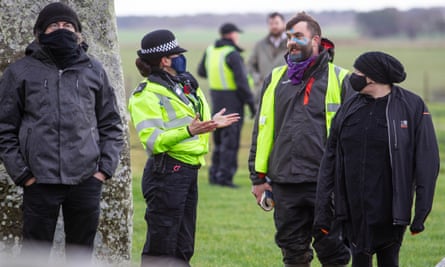More than 100 protesters have staged a trespass at Stonehenge to raise concerns over plans for a two-mile tunnel underneath the world heritage site.
Last month the transport secretary, Grant Shapps, approved the £1.7bn project, which will include eight miles of extended dual carriageway along the A303 in Wiltshire.
A broad alliance of residents, ecologists, land justice and climate activists and pagans joined the trespass. There was singing, drumming and speeches about the damage they say the road-building plan will cause.

A small number of police officers, along with English Heritage officials and security guards, maintained a low-key presence and did not try to halt the mass trespass.
Speakers at the monument expressed concerns about the government’s £27bn roads programme, and their overruling of planning inspectors’ recommendations against approving the £2bn eight-mile dual carriageway and two-mile twin-bore tunnel at the site.
One of the scheme’s key controversies is that the proposed tunnel will run under only part of the Stonehenge site, with the entry and exit portals located within the Unesco-protected boundary.
Dan Hooper, who became well known during the 1990s roads protests as “Swampy”, attended Saturday’s mass trespass. He said: “This is the coming together of people who are saying we have had enough. As road transport is the single largest source of carbon emissions in the UK, this is insane. Building more roads simply leads to more traffic and carbon.
“The government is ignoring the uncomfortable but very real truth that time is running short. Now is a critical time to rethink our connection with nature. We need to put a stop to these road schemes as we did before.”
Indra Donfrancesco, one of the protesters, said: “Stonehenge is a revered place of our ancestors from a time that worshipped nature and is now awakening the spirit of the people to rise, calling us to act to defend our planet for its survival.”
Everyone at the trespass was urged to sign up to a Beat the Bulldozer pledge, which is being coordinated by the Stonehenge Heritage Action Group.
Shapps overruled a report by five planning inspectors who recommended withholding consent for the scheme. The road improvements are intended to widen traffic bottlenecks on a major route to south-west England.
Historic England and the National Trust argue that diverting the road underground will enhance the site, but druids, green campaigners and archaeologists have opposed the plans.

Shapps accepted that the development would cause harm to the 4,000-year-old Unesco world heritage site, but concluded that it would not be substantial and would be outweighed by the public benefit.
The campaign group Save Stonehenge World Heritage Site (SSWHS), a new organisation set up by supporters of the Stonehenge Alliance, has begun a fundraising campaign to pay for the legal action. In its letter to Shapps, the organisation said the proposals were in breach of Unesco’s world heritage convention.
In March, the government announced the £27.4bn RIS2 roads programme, including the A303 Stonehenge scheme. The Planning Inspectorate, which examined all the evidence and concluded there would be “permanent, irreversible harm” to the site, recommended that the scheme be rejected.
A legal challenge is being launched. SSWHS has commissioned the law firm Leigh Day and the barristers Victoria Hutton and David Wolfe QC to investigate the lawfulness of the decision.
Stonehenge, together with Avebury and the surrounding landscapes, were designated a world heritage site in 1986 because of their unique neolithic and bronze age monuments and sites dating back 6,000 years.
The Department for Transport outlined its reasons for giving the scheme the green light in a decision letter.
